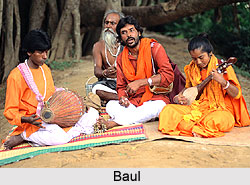 Baul music of the Birbhum district is one of the streams of the general section which is distinctly situated in different areas and characterized as folk-music. Actually Baul music forms a sectarian cult with specialized composition in language, it is folk religion deeply rooted in the general culture of the people. As a cult, Baul underwent several mutations due to the influence of ideas and thoughts from diverse sources. In the following are traced the chief stages of its transformation:
Baul music of the Birbhum district is one of the streams of the general section which is distinctly situated in different areas and characterized as folk-music. Actually Baul music forms a sectarian cult with specialized composition in language, it is folk religion deeply rooted in the general culture of the people. As a cult, Baul underwent several mutations due to the influence of ideas and thoughts from diverse sources. In the following are traced the chief stages of its transformation:
(1) It started originally under the impact of Mahayana Buddhism (1000 A.D.). Later, it accepted yoga-tantric religious observances, and developed on the line of thoughts preached by Sahajias.
(2) Thereafter it fell under the spell of Natha cult from which it imbibed the adoration or worship of guru (the master).
(3) This was followed by its being influenced by the teachings of Sufis which emphasized the direct experience of soul through the human body.
(4) Then with the arrival of Vaishnavism, it came close to it, and learnt how harmony between love and soul could be affected symbolically through direct experience of physical body.
As a result of the blending of all these ideas and influences, Bauls eschewed every kind of ritual and custom, and stood firmly against practices that went under the banner of traditional religions. Baul believe that divinity is present in the human body itself and not anywhere outside, neither in holy places, nor in temples, nor in mosques. After the culture of purification of the human body they intend to derive strength from the soul where God`s strength is enshrined. They negate all kinds of ritualism. According to them it is the magic force inside the human body that forms the mystic personality named maner manus (the soul). Baul songs are of symbolic types but full of wit and imageries picked up from common usages. Yet Birbhum Bauls and also some others of different areas focus their ideas on old Vaisnava personalities like Jaydeva, Chaitanya and so on. They tell the story of the soul in a peculiar language of their own that brings forth imageries from life itself.
The language of composition naturally does not indicate the traces of rural colour in many instances. Intricate symbolic forms of expression may apparently be incomprehensible to others who are not conversant with the people and their cult. The nature of the language and expressions, on the other hand, are followed well by the rural people of West Bengal. There is no definite record of historical details of development till the nineteenth century.




